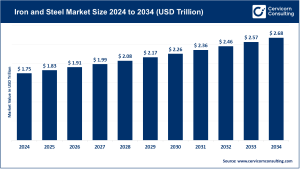Industrial Enzymes Market Size
The global industrial enzymes market was valued at USD 7.95 billion in 2024 and is projected to reach USD 13.90 billion by 2034, growing at a CAGR of 5.75% from 2025 to 2034.
What is the Industrial Enzymes Market?
The industrial enzymes market encompasses the production and application of enzymes—biological catalysts—in various industrial processes. These enzymes accelerate chemical reactions, offering more sustainable and efficient alternatives to traditional chemical processes. They are utilized across multiple sectors, including food and beverages, textiles, detergents, biofuels, and pharmaceuticals. The market is characterized by a diverse range of enzymes, such as amylases, proteases, lipases, and cellulases, each serving specific industrial functions. The global industrial enzymes market was valued at approximately USD 7.95 billion in 2024 and is projected to reach around USD 13.20 billion by 2033, growing at a compound annual growth rate (CAGR) of 5.8% from 2024 to 2033 .
Market Trends
-
Sustainability and Eco-Friendly Practices: Industries are increasingly adopting enzymes to replace harsh chemicals, aligning with global sustainability goals. Enzymes offer environmentally friendly alternatives in applications such as biofuel production, wastewater treatment, and textile processing.
-
Technological Advancements: Innovations in enzyme engineering, including genetic modification and protein optimization, are enhancing enzyme efficiency and stability. These advancements enable enzymes to perform under a broader range of conditions, expanding their applicability in industrial processes.
-
Rising Demand in Food & Beverages: The food and beverage sector remains a significant consumer of industrial enzymes. Enzymes are utilized to improve product quality, texture, and shelf life, catering to the growing consumer preference for processed and convenience foods.
-
Biofuel Production: The shift towards renewable energy sources is driving the use of enzymes in biofuel production. Enzymes facilitate the conversion of biomass into bioethanol and biodiesel, offering a more sustainable approach to energy production.
-
Regulatory Support: Governments worldwide are implementing regulations that encourage the use of bio-based products. Policies promoting environmental sustainability are fostering the adoption of enzymes in various industrial applications.
Market Dynamics
-
Drivers:
-
Environmental Regulations: Stricter environmental laws are prompting industries to adopt cleaner technologies. Enzymes, being biodegradable and less toxic, help companies comply with these regulations.
-
Cost Efficiency: Enzymes can reduce energy consumption and raw material costs in industrial processes, offering economic benefits to manufacturers.
-
Consumer Preferences: There is a growing consumer demand for natural and clean-label products, driving the use of enzymes in food and beverage manufacturing.
-
Industrialization in Emerging Economies: Rapid industrialization in regions like Asia-Pacific is expanding the market for industrial enzymes, particularly in sectors such as textiles and detergents.
-
-
Restraints:
-
High Production Costs: The production of industrial enzymes can be costly, limiting their adoption in price-sensitive markets.
-
Stability Issues: Some enzymes may lose activity under extreme industrial conditions, posing challenges in their application.
-
-
Opportunities:
-
Emerging Markets: Developing economies present significant growth opportunities due to increasing industrial activities and demand for sustainable solutions.
-
Innovation in Enzyme Applications: Ongoing research and development efforts are leading to the discovery of new enzyme applications in various industries.
-
-
Challenges:
-
Regulatory Hurdles: Navigating the complex regulatory landscape can be challenging for companies looking to introduce new enzyme-based products.
-
Market Competition: The presence of established players and the development of alternative technologies pose competitive challenges.
-
Regional Analysis
-
North America: North America led the global industrial enzymes market with the highest market share of 37% in 2024. The region’s dominance is attributed to the strong presence of end-use industries such as food and beverage, pharmaceuticals, laundry detergent, and personal care and cosmetics. Additionally, the high scope for research and development activities in the region’s major countries contributes to its leading position.
-
Asia-Pacific: The Asia-Pacific region is expected to grow at the fastest rate during the forecast period. Countries like China, India, Japan, and South Korea are witnessing rapid industrialization, increasing the demand for industrial enzymes. The region’s growth is also driven by supportive biotech policies and a growing focus on clean processing in industries like food, textiles, and wastewater treatment.
-
Europe: Europe emerged as the second-largest consumer of industrial enzymes. The presence of major pharmaceutical and cosmetic businesses in the region is projected to drive enzyme demand. Additionally, Europe’s emphasis on sustainability and environmental regulations is fostering the adoption of enzyme-based solutions.
Recent Developments
-
Novozymes and Chr. Hansen Merger: In December 2022, Novozymes announced a merger with Chr. Hansen, a Danish company specializing in agricultural, pharmaceutical, and food ingredients. This strategic move aims to enhance the companies’ capabilities in enzyme production and expand their market reach.
-
Allozymes Series A Funding: Allozymes raised $15 million in Series A funding, led by Seventure Partners of France and Xora Innovation of Singapore. This investment will support Allozymes in advancing its enzyme discovery and engineering technologies, positioning the company to revolutionize various industries with innovative enzymatic solutions .
-
Prozomix and Ginkgo Collaboration: Prozomix is collaborating with Ginkgo to develop next-generation enzyme plates for sustainable active pharmaceutical ingredient (API) manufacturing. This partnership aims to enhance the efficiency and sustainability of pharmaceutical production processes.
Conclusion
The industrial enzymes market is poised for significant growth, driven by technological advancements, regulatory support, and increasing demand for sustainable solutions across various industries. As companies continue to prioritize efficiency, sustainability, and cost-effectiveness, the role of industrial enzymes will become increasingly pivotal in shaping the future of manufacturing and processing. The ongoing developments and strategic collaborations within the industry further underscore the potential and importance of industrial enzymes in the global market.
For more detailed insights and data, you can visit the original source: Cervicorn Consulting – Home Healthcare Market
Read: Hydrogen Energy Storage Market Trends, Dynamics, and Regional Insights

